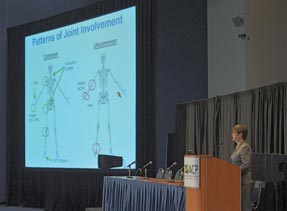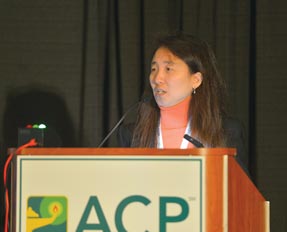4 steps to managing osteoarthritis pain in the elderly
Weight loss and nutritional counseling should be the first step, while opioids are always and only a last resort.
There is a 4-step process for managing osteoarthritis pain in elderly patients, Carla R. Scanzello, MD, PhD, told attendees at her Internal Medicine Meeting 2016 session, “Great Coronaries but Rusty Joints.”
The first step should always be management of modifiable risk factors, such as weight loss and nutritional counseling, said Dr. Scanzello, who is assistant professor of medicine in the Division of Rheumatology at the University of Pennsylvania and the Corporal Michael J. Cresenz VA Medical Center in Philadelphia. “Even though this can often be a frustrating thing for both you and the patient ... you just have to start here,” she said.

She pointed to data from the Intensive Diet and Exercise for Arthritis (IDEA) trial, which she said has taught clinicians a lot about the impact of weight loss in knee osteoarthritis. Published in JAMA in 2013, the IDEA trial randomly assigned patients to an exercise-only arm, a diet and exercise arm, or a diet-only arm. At 18 months, mean weight loss was 23.4 pounds for the diet plus exercise arm, 19.6 pounds for the diet arm, and 4 pounds for the exercise arm; patients in the diet plus exercise arm also showed the greatest degree of reduction in pain scores, Dr. Scanzello said.
“The degree of weight loss here may not seem like a lot, but what this translates into for a 230-pound person is really 10% of their body weight,” she said. “There are other studies showing that 5% to 10% of body weight loss can have a significant impact on the pain experience in knee [osteoarthritis], so I use that information to try to help motivate my patients.”
Dr. Scanzello also noted that the impact of weight loss on knee osteoarthritis in the IDEA trial couldn't fully be explained by a reduction in the load borne by the knee joint. While diet plus exercise was most effective for weight loss and pain reduction, the diet arm yielded the greatest degree of load reduction. Subsequent studies from the IDEA trial and other investigators have shown that inflammatory factors, specifically interleukin-6, seem to be affected by exercise, Dr. Scanzello said, so the effects seen in the diet plus exercise arm are most likely the result of both load reduction and anti-inflammatory effects.
The second step in pain management, she said, involves managing patients' expectations and educating them on what osteoarthritis is and what it is not. To avoid needlessly discouraging patients, clinicians should stress that osteoarthritis is not normal aging, that not all patients will eventually need surgery, and that “wear and tear” are risk factors but not the sole disease mechanisms.
“I think the concept that they are wearing out their joints ... may lead to patients thinking that exercise is not good, that they're going to wear out their joints even more, and they're afraid of that,” she said. “It's really important to stress that exercise is good here.”
The third step focuses on nonpharmacologic treatments, Dr. Scanzello said. Specific exercises and physical therapy can help maintain function and range of motion, especially in elderly patients. They can also improve balance in those with significant instability symptoms and can reduce chronic pain, she said. She also noted that many studies have shown benefits from strength training, aerobic and water-based exercise, tai-chi, yoga, and acupuncture.
“When you actually look at the big clinical trials, physical therapy as well as some of these other therapies don't look so stunning. However, I want to stress that in the bigger trials here we're lumping all of our patients together as if they have exactly the same disease, whether they're post-traumatic, obesity-related, or idiopathic,” she said. “And the sham arms in these exercise therapies are often active arms where patients are getting significant attention from the medical community, and that has a tremendous impact on chronic pain conditions like [osteoarthritis].”
Dr. Scanzello reminded the audience that knee braces can improve stability and may reduce chronic pain, although the latter outcome has been poorly studied, and that assistive devices, such as walkers, can help elderly patients maintain independence and function.
The fourth and final step in management of osteoarthritis pain is use of pharmacologic options, Dr. Scanzello said, beginning with topical agents, such as capsaicin and diclofenac gel. “Don't forget about the topicals. I institute these early,” she said. However, she noted that although capsaicin has been shown to be effective for knee and hand osteoarthritis pain in clinical trials, it can be problematic in the elderly because it produces a burning sensation and should not be used if skin integrity is compromised.
NSAIDs have been shown in clinical trials to be the most effective oral agents available for osteoarthritis pain, but they need to be used wisely because of their well-known gastrointestinal, renal, hepatic, and cardiovascular toxicities, Dr. Scanzello said. Care should be taken in patients who have comorbid conditions that might increase their risk for complications, especially cardiovascular events, she said: “In the patient who really relies on these [drugs], I think just close communication with the cardiologist is warranted.”
Dr. Scanzello also stressed the potential utility of duloxetine, which is a serotonin-norepinephrine reuptake inhibitor approved by the FDA in 2010 for musculoskeletal and low back pain, including osteoarthritis pain. She recommends a dose of 30 to 60 mg daily and noted that duloxetine can be considered in patients with chronic pain who cannot tolerate NSAIDs or in whom NSAIDs have failed. Also, she said that she often considers duloxetine to avoid polypharmacy in patients with concomitant depression, after communication with their mental health practitioners.
Intra-articular corticosteroid injections have yielded mixed results in randomized controlled trials but are still considered in practice because they can be effective in some patients, Dr. Scanzello said. “I use these quite often in management of episodic flares and in management of patients with comorbidities in order to limit use of those oral agents,” she said. Intra-articular corticosteroids can also be used as a bridge to joint replacement and as an alternative to joint replacement in patients with contraindications, she said. She also noted that these injections can temporarily increase blood glucose levels in diabetic patients.
Dr. Scanzello pointed out that the 2014 Osteoarthritis Research Society International (OARSI) guidelines for nonsurgical management of knee osteoarthritis recommend different approaches based on whether patients have single or multiple joints involved. Those in the former category may start more quickly with intra-articular injections, while those in the latter category may first start with oral agents, she said. She also noted that duloxetine has also been added to the OARSI guidelines as a potential therapy.
“Notably what is absent here are opioids,” said Dr. Scanzello. “I really reserve these only as a last effort to avoid the problems we have treating chronic pain with opioids in the elderly.”




